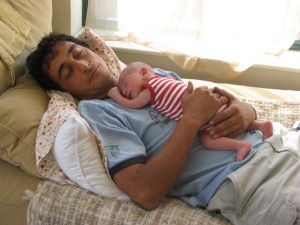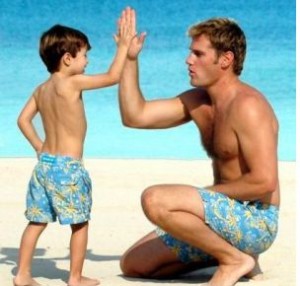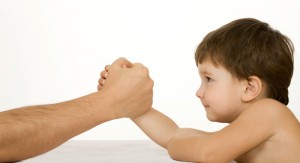Me and My Kid
The practice of sitting with other men in many hours of Touch Practice has sharpened my awareness of seemingly opposite characteristics within myself. There is a part of me that loves to hold other people and take care of them. But there is another side of me that longs to be held and taken care of.
There’s a side of me that is fiercely courageous, confident, and secure; there’s another side of me that wonders if anybody really loves me. (What if they’re all faking it to avoid hurting my feelings?) And there’s a piece of me that feels like a big, strong guy, and another piece that feels very childlike and small.
One of the ways we can actively work with shadow is to try to unsharpen these opposite faces of our personality, to introduce them to each other and to recognize them as two sides of a coin or two poles of a magnet. That is the work of integration. So this week, I’ve been watching that childlike, insecure half of myself that longs to be held, literally or figuratively, by someone bigger and stronger, inviting him to talk to me.
Human beings are born a writhing bundle of unmet needs. Left on our own, most human babies would die within hours, certainly within a day or two. Unlike baby fish, the chances of a newborn human baby taking care of its own basic needs for food and shelter are an absolute zero. Unlike baby fish, a human infant’s ability even to move or position itself is almost nonexistent.
 One of the reasons that humans react so strongly to the psychodynamic force of authority is because we are utterly dependent for such a relatively long period of our early lives on someone bigger and more powerful than we are. Frogs and lobsters don’t have authority issues, at least none they need to talk to their therapists about. They don’t experience the extreme dependency that humans do in the early part of their lives.
One of the reasons that humans react so strongly to the psychodynamic force of authority is because we are utterly dependent for such a relatively long period of our early lives on someone bigger and more powerful than we are. Frogs and lobsters don’t have authority issues, at least none they need to talk to their therapists about. They don’t experience the extreme dependency that humans do in the early part of their lives.
When most of us see a baby in all of its utter neediness, we instinctively want to pick it up and cuddle it, feed it, wrap it in a blanket and do our absolute best to take care of every need it has.
On the other hand, when we see any sort of neediness in someone we’re getting to know, many of us turn and run, not walk, in the opposite direction. When we encounter it in a conversation at a party, some of us take that opportunity to excuse ourselves to “freshen” our drink. And when we experience that sense of “I need” even in long-term friendships, we sometimes feel weighed down, like an anchor is dragging on the ocean floor, taking some of the fun out of sailing in that particular boat.
The question that interests me is this: why do we react to each others’ neediness and helplessness with “oh, that’s adorable” in a 3-week-old baby, but “oh you have to be kidding me” when it comes up in a 40-year-old friend? Why are we attracted to helplessness in some human beings and repulsed by it in others? How come “needing” looks cute on some people and really annoying on others, like a color that some people can wear and others shouldn’t try?
I’ve actually had to wrestle pretty hard with this question this week, because the answer was not immediately obvious to me. But, I have to return to what I have learned about attraction and aversion, and these opposite reactions around having needs or being helpless have all the telltale signs of an attraction/aversion reaction.
If that’s true, then I’m generating it myself. The reason the baby looks adorable and the adult friend looks, well, just “needy,” has to do with the difference in the way I’m looking at them, the lens through which I view them. And that (drumroll, please) has to do with the way I see myself.
Ugh. Might I have needs? Perhaps even feel reminders of that helplessness from long ago? This blog is already heading places I’d rather not go.
How do we men make the journey from being utterly helpless at birth to reaching a state of strong, ruggedly masculine independence where all of our needs are met through self-care?
Well, for starters: we don’t.
It’s a long road, and we never really reach the point of complete independence, although men can do a rather remarkable job of projecting that illusion. If we’re lucky, we experience a healthy and satisfying state of interdependence, but that’s a pretty complicated dance. At least it is for me.
 As we move through the developmental stages of our lives, we slowly accumulate resources to meet our own needs, including emotional and physical capacity. We learn to walk, and to be responsible for moving ourselves around.
As we move through the developmental stages of our lives, we slowly accumulate resources to meet our own needs, including emotional and physical capacity. We learn to walk, and to be responsible for moving ourselves around.
We learn how to delay gratification, the practice of being able to wait patiently for something we need rather than throwing a tantrum if we can’t have it right now (although American consumer-culture encourages us to give up this skill later in life, as you can witness at virtually any customer service counter. Increasing numbers of previously grown-up people want what they want, right now, throwing tantrums and celebrating the two-year-old in each of us. This is progress?)
Ultimately we learn to handle some really sophisticated needs. We learn how to take care of ourselves when we’re lonely. We build something called “self-esteem,” our ability to validate that we are capable of loving and being loved, rather than waiting for someone bigger and stronger to constantly reassure us with a bottle, pacifier, or hug. We learn how to maintain our own good feelings (and endure less fun feelings) without depending on someone else.
And I’ve done that, for the most part. I’m conscious of having done that work, and it works pretty well.
 Yet, despite all that: there are days when some part of me just wants someone bigger and stronger to come along, pick me up and hold me–fix things–make everything ok–and help me feel loved and lovable. That little kid is still in there, riding around on my back, playing horsey. And every once in a while I can feel him kick the horse.
Yet, despite all that: there are days when some part of me just wants someone bigger and stronger to come along, pick me up and hold me–fix things–make everything ok–and help me feel loved and lovable. That little kid is still in there, riding around on my back, playing horsey. And every once in a while I can feel him kick the horse.
I think, for me, the key to balance in this adult life–how we engage our needs and interdependencies without being overrun by them–comes from understanding that the little kid belongs to me, and I take him home at the end of the day and am ultimately responsible for him. That doesn’t mean, however, that I never let others play with him, or even let them take him for an hour or half a day. I do.
Touch Practice is one of the places I do that, in a very highly structured way. It provides one carefully constructed, well grounded, conscious and aware hour where I can experiment with needing and being needed, comforting and being comforted, nurturing and being nurtured, and, alternately, being the strong protector or the fragile object being protected. And because the work is based on partnership, I can offer the same chance to experiment to the person who shares the hour with me.
 I used to consider this a way of “working” on myself, but more and more, I consider it a form of play. And I have less-structured cuddly relationships, and even some friendships, where I can play as well, and explore, alternately, being the super-human strong guy who comes to the rescue, or the fragile object in need of protection. I have both animals in me, both capacities.
I used to consider this a way of “working” on myself, but more and more, I consider it a form of play. And I have less-structured cuddly relationships, and even some friendships, where I can play as well, and explore, alternately, being the super-human strong guy who comes to the rescue, or the fragile object in need of protection. I have both animals in me, both capacities.
For me, the balance between denying our needs or having them overwhelm us (or others) has something to do with the phrase “plays well with others.” Healthy play is mutual, it’s balanced, it take turns playing different roles. I don’t always get to play the sheriff; sometimes I have to play the outlaw too. Sometimes I get to talk; sometimes it’s my turn to listen. I try to be of service to others at least as often as I try to ask for help, and believe me, sometimes I have to remember to ask for help.
Healthy play respects the limits and capacities of each person. Healthy play recognizes that we’re each, ultimately, responsible for our own experience and our own happiness.
So while I often let my little kid out to play with others for an hour or an afternoon, I’ve learned not to send him away with anyone, or expect that they’re going to take care of him for life. At the end of the day, he comes home with me, on my back, kicking the horsey, played out, tired, but well cared for.
Have thoughts you’d like to share?
Touch Practice is a sacred practice for me, and part of that is keeping confidences sacred. While a name and e-mail address are required to post a comment, feel free to use just your first name, or a pseudonym if you wish. Your e-mail address will never be seen by or shared with anyone. It is used to prevent spam and inappropriate comments from appearing in the blog. I’d really like to hear from you!














Beautifully said/written. This is the 2nd page of your blog I’ve read. I’m enjoying them – and your photo selections are amazingly well-suited. Thanks.
Hey Frank, glad to have you here. Thanks for reading and for taking the time to comment.
Kevin- thanks yet again for another wonderfully written and insightful offering. As I mentioned to you last week, I greatly appreciate your openness and ability to create that space not only for yourself but for so many others. It is a privileged time sharing that responsibility of playing with your kid and also being invited to be one of the other kids invited over to play and to explore and to re-discover that kid within me that has been somewhat neglected of left behind. That experience opened my heart up that much wider and I look forward to being a better caretaker and playmate for my own kid, and hopefully, the kid in others, too. thanks, again!!
Thanks so much for this.
Years ago I read a work by Ashlegh Montegue (?) spelling which i think was entitled Touching. It was much more of a psycholigical “study” verses any sort of self help expose. Yet, it was remarkable in that it revealed what happens to living things when they are not TOUCHED (and what ever variation).
The examples were extreme. But, it served the purpose.
We need to touch and be touched physically.
Best,
Joe
Hi Joe–thanks for your comment. Here’s a link to the book you mention:
http://www.amazon.com/Touching-Human-Significance-Ashley-Montagu/dp/0060960280
The right touch at the right time: lifesaving. The wrong touch at the wrong time: Devastating. As the story about the man “helping” the butterfly out of the cocoon demonstrates, good intentions are not enough: we need to be sure, to ask, to see, if the touch is wanted, welcome, helpful to the other being. Otherwise good intentions can nonetheless be harmful and destructive to people. Appreciate your writing in.